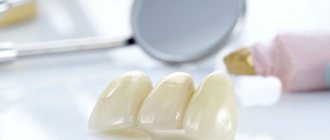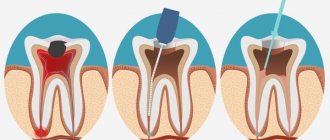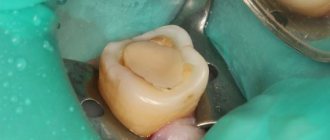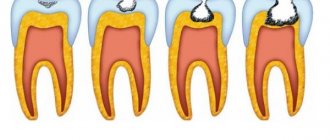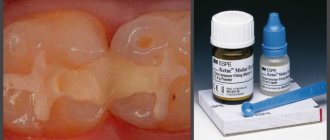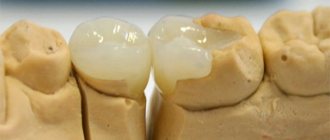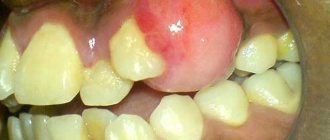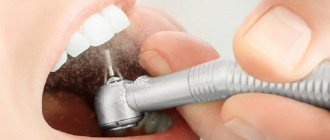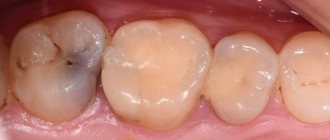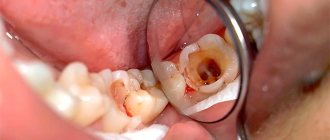What are they needed for?
Filling materials, to varying degrees, irritate the dental pulp. For multicomponent materials, the matrix can be toxic. But this does not mean that all dental treatment products contain irritating properties. Isolating pads in dentistry are used not only to remove the negative impact on loose connective tissue, but also for:
- preventing the ingress of toxins;
- protection from filling material, which can have a destructive effect on tooth tissue;
- reducing the risk of microcracks forming during shrinkage of the filling.
What are the requirements for gaskets? Here are just a few of them:
- Long-term protection of dentin from chemical attack
- Protection of enamel from high and low temperatures.
- Protection from the aggressive effects of saliva.
- Stronger adhesion to the tooth compared to a filling.
- Does not affect the pulp.
- Easy to install.
There are two options for isolating gaskets in dentistry:
- The first option is the base one (a layer of more than one millimeter). It protects the pulp from external irritants, maintains the shape of the cavity, and is also an integral part of more expensive fillings.
- The second option is thin-layer. Does not fully protect against external irritations. Provides stronger adhesion between filling and tooth.
There are several groups of gaskets.
Application area
The main purpose of any insulating gasket is to eliminate the impact of the filling material on the pulp. It also isolates the nerve of the tooth from toxins, protects against the occurrence of microcracks and marginal gaps that can form after the filling shrinks.
Requirements for insulating gaskets
The insulating gasket must:
- Protect dentin from chemical and temperature irritants;
- Easy to install;
- Withstand the most aggressive effects of saliva if the integrity of the filling is compromised;
- Withstand the maximum possible chewing load;
- Be bonded to the tooth more strongly than to the filling;
- Do not have a negative effect on the dental pulp.
Also, the insulating lining should not change the natural color of the tooth enamel.
Indications and contraindications
Medical pads are necessary in the following cases:
- deep caries (close to the pulp);
- focal pulpitis;
- if there is an accidental opening of the pulp.
Quite a lot of research has been done on the tolerability of therapeutic pads. It has been proven that therapeutic pads do not cause allergic reactions or pulp irritation.
Benefits of therapeutic pads
Therapeutic pads have both anti-inflammatory and regenerating, necrotizing and analgesic effects. The gasket material has good ductility and hardens quickly. Such a lining significantly reduces the risk of developing secondary caries and the formation of microcracks.
Flaws
It should be noted that therapeutic pads, for all their advantages and positive effects on the pulp during inflammatory processes, also have quite serious disadvantages, which, if used incorrectly, can lead to a number of problems:
- Therapeutic pads do not have the property of adhesion to dentin, which leads to weakening of the adhesion of the filling to various dental tissues;
- The healing materials of the pad gradually dissolve, dissolve, and this creates conditions for further infection of tissues;
- If the materials of the treatment lining get on the walls of the cavity formed during the treatment process, it causes microbes to enter the tooth, which will lead to secondary caries.
That is why the use of therapeutic pads for inflammation in the teeth should be trusted only to a responsible specialist who will not make mistakes and ultimately guarantees the quality of treatment and installation of a filling on the tooth.
Basic principles of therapeutic pads
The therapeutic pad can be:
- non-hardening;
- fast-hardening;
- long-hardening.
The composition of the base material is polymer, aqueous, oil or monomer. Dentists use either ready-made medicinal pads or prepare them themselves.
How to treat deep caries
Treatment of deep caries has its own characteristics. The large depth of the tooth cavity requires isolation from the bottom of the surface using a special material. This is necessary to eliminate chemical irritation of the pulp by the filling. The question arises whether it is possible to fill the affected tooth in one visit, or whether a repeat visit will be required.
If caries does not develop rapidly, the patient does not suffer from pain, then it is possible to carry out treatment in one visit. In this case, the pulp is not isolated; a regular filling is used.
When the doctor experiences difficulties in diagnosing and finds it difficult to determine how far the carious process has developed, then treatment is carried out with the installation of a temporary filling. A week later, a permanent one is placed, provided the patient has no complaints. If pain is present, then most likely pulpitis has begun and this requires other methods of treating deep caries (including pulp removal).
In acute cases of deep caries and a thin, loose bottom, different approaches are needed. It happens that all treatment is performed in one visit and a second visit to the dentist is not required. But in some cases, a therapeutic pad is placed (up to six months) to produce replacement dentin. This cannot be done without temporary material. After this period, the treatment of deep caries is completed with the installation of a permanent filling.
Types and purpose
In dentistry, a gasket is a layer of medicinal materials placed on the bottom and/or wall of a carious cavity prepared for filling.
This is interesting: A filling fell out of a tooth: how long can you walk without it, what to do
Thus, the gasket acts as an additional barrier between the filling and the pulp. It performs the following functions:
- It has a bactericidal effect on pathogenic microorganisms that remained unremoved during the treatment of the carious lesion.
- Creates an obstacle to the penetration of infection into the pulp when the seal is depressurized.
- Activates mineralization and formation of secondary dentin in the tooth. Thanks to this process, the thickness of the bridge between the cavity and the pulp increases.
- Relieves the sensitivity of the restored tooth , which can occur when the thickness of the dentinal layer between the filling and the pulp is small.
According to their functions, pads are divided into therapeutic and insulating types.
Medicinal
Therapeutic pads are applied mainly in cases where the cavity is located very close to the pulp. It is believed that in order to prevent toxins from penetrating into the pulp, the thickness of the dentin layer must be at least 2 mm.
Reducing it to 1 mm prevents the penetration of microorganisms in 90% of cases, and to 0.5 mm – only in 75%. In addition, the thicker the bridge, the higher the survival rate of odontoblasts in it and the more active the reparative processes in dentin.
Therapeutic pads are indicated in the following cases:
- Deep caries, in which the thickness of the bridge between the filling and the pulp chamber is less than 1 mm.
- Acute non-purulent pulpitis.
- Accidental opening of the pulpous chamber during tooth preparation or due to injury. In this case, the gasket is placed directly on the pulp.
The healing material covers the entire bottom of the carious cavity or lies precisely in the areas of the pulp horn.
Modern therapeutic pads are made primarily on the basis of calcium hydroxide (Ca(OH)2), which has a bactericidal effect and shifts the pH of the environment in the tooth cavity to the alkaline side, which leads to neutralization of acids.
Thanks to numerous studies, it has been established that even if necrotic and infected tissues are partially left in the cavity, the carious process stops thanks to calcium hydroxide.
The main problem with Ca(OH)2 gaskets is that they have relatively little adhesion to dentin, which creates a risk of cracks and infection entering the pulp.
In addition, the material of the therapeutic pads is susceptible to dissolution and opening, resulting in a path for infection of the pulp. Gaskets perform worst when working with composite fillings.
The most commonly used brands are:
- Dycal. Chemically cured two-component material (paste + catalyst), consisting of 25% calcium hydroxide. Can be used with any filling material.
- Life. The main active ingredient of the drug is also calcium hydroxide.
- Calcipulpe. Calcipulpe. A product with Ca(OH)2, used to relieve tooth sensitivity, deep caries and some forms of pulpitis.
Insulating
Insulating gaskets are designed to solve the following problems:
- isolation of pulp and fillers from filling material;
- increasing the adhesion strength between the filling and dentin;
- increasing the impermeability of medical pads (overlaid on top of them).
The material is indicated for the treatment of moderate, deep and complicated caries, as well as for endodontic treatment. Its use is determined, first of all, by the fact that many filling materials irritate the pulp, and to avoid this, the tooth tissue is isolated with spacers.
The most commonly used insulating gaskets are made from glass ionomer cements. They are usually two-component, consisting of powder and liquid.
The first contains calcium and aluminum fluorosilicates and fluorine compounds. The liquid is a solution of polycarboxylic (polyacrylic, polymaleic, polyitaconic) and tartaric acids.
Another combination of materials is possible, in particular, distilled water and powder containing, among other components, polycarboxylic acid.
Depending on the type of curing, insulating glass ionomer gaskets can be chemically or light-cured. The most famous and in demand are the following types:
- Ionoseal . Contains fluoride, which reduces the risk of secondary caries. Durable, light-curing, acid-resistant, has good adhesion to composites and dentin.
- Fuji Lining . Photocurable. Low shrinkage during hardening.
- Fuji IX . The chemically cured material has the properties of a classic glass ionomer cement.
- Ionosit Baseliner. Compomer (hybrid) dual curing - light and chemical reaction. Hardening is accompanied by slight expansion (1-2%), which compensates for polymer shrinkage. Very durable.
- A universal preparation used for gaskets and temporary fillings.
- Time Line. Light cured.
What filling materials are used?
Filling materials are used to fill a carious cavity. This is done after thorough cleaning of the tissue affected by necrosis. The filling is able to return the tooth to an almost ideal shape and plays an isolating role in case of possible infection.
For filling in the treatment of deep caries, various fillings are used - both temporary and permanent. Temporary ones are used during the intermediate stage of treatment, when contact with irritating factors should be limited. The permanent one is installed for many years.
There are several types of permanent fillings: composite; cement; compomer; metal; in the form of tabs.
Cements
Silicate and phosphate cements, as well as glass ionomer cements, have proven themselves well. Silicate ones are used to achieve a cosmetic effect, as any shade can be selected. They are able to release fluoride, which provides an additional opportunity to avoid re-damage to the crown.
Glass ionomers are good because they fit tightly with the crown of the tooth. This material hardens under the influence of ultraviolet light. It is convenient for the doctor to slowly form a crown of the desired shape. Their disadvantage is that they wear out quickly and can also absorb food coloring.
Light-curing fillings
Light-curing and photopolymer fillings consist of filler and polymer. They harden under the influence of light from a lamp (polymerization). Fillings made from this material are considered the most effective in modern dentistry. These materials help the dentist work effectively, creating the desired size and shape directly in the oral cavity. What are the main advantages of such a filling:
- hardens efficiently and quickly;
- choosing any shade you like to match the color of your tooth enamel;
- restoration effect even on the front teeth;
- The dentist creates the form without limiting himself in time.
Chemical fillings
Fillings received this name due to the fact that their hardening is possible if various components are connected. The materials are mixed before the procedure begins. Chemical fillings are made from glass ionomer cement as well as composite. Glass ionomers contain powder, liquid, and additives for rapid hardening.
Advantages of glass ionomer filling:
- absorbs fluoride ions when fluoride toothpaste is used;
- fits tightly, gives the desired resemblance to tooth tissue;
- the release of fluoride ions prevents carious lesions.
Advantages of composite fillings:
- not subject to splitting;
- no reaction with oral fluid;
- high strength.
Fillings in dentistry - main types and differences
Materials used
Padding materials contain various active components - zinc compounds, eugenol, calcium hydroxide and glycerophosphate, steroidal and non-steroidal anti-inflammatory drugs, etc.
This is interesting: The main causes of the problem of black teeth in children - why a child’s enamel turns black
They are produced in different forms - aqueous suspension, ionomer cements, varnish, zinc-eugenol and combined pastes, light-curing polymer materials.
Aqueous suspensions
They are a powder containing calcium hydroxide mixed with water. It is possible to add other components, in particular, radiopaque agents. An example of the composition of Calcesept material: calcium hydroxide + barium sulfate + isotonic solution.
The gasket is applied in a thin layer, dried and closed with a temporary filling. After 1.5 months the gasket is changed.
Disadvantages of the material:
- the need to avoid contact with air due to loss of medicinal qualities;
- resorption, necessitating repeated applications to ensure the formation of secondary dentin;
- cannot be used simultaneously with filling mineral cements that contain acids that react with calcium hydroxide.
Ionomer cements
Ionomer cements based on calcium compounds with chemical curing are the most successful materials, superior to other types of gaskets. Hydroxide and ether are mixed in a 1:1 ratio before application and cure in the mouth.
Advantages of gaskets made from glass ionomer cements:
- strong chemical adhesion to dentin and filling material, which increases due to the slight volumetric expansion of cement during hardening;
- no negative impact on the pulp (the molecules of the material are larger than the dentinal tubules);
- the presence of fluoride compounds that strengthen dentin;
- resistance to oral fluid;
- good strength properties;
- acceptable aesthetics (when using the material as a filling);
- compatibility with composite filling materials;
- ease of use;
- low price;
- low solubility, no need to reapply.
Disadvantages of glass ionomer cements:
- duration of hardening (about a day), during this time the tooth should not be subjected to stress;
- dependence of the strength of the hardened material on environmental parameters - for example, excessive dryness of the filling;
- cracking if overapplied.
Insulating gaskets based on polycarboxylate cements
It contains powders of magnesium and zinc oxides with the addition of polyacrylic acid. Sometimes water is used instead of acid in such gaskets. Polycarboxylate cements do not cause irritation to the pulp, harden very quickly (literally within three minutes after preparing the mixture), and adhere well to tooth tissue. The disadvantage of these mixtures is that they can completely dissolve under the influence of saliva after a certain time, and they are also difficult for the dentist to work with due to their rapid hardening.
Insulating varnishes
These products are also used in dental practice. They belong to insulating gaskets. Consists of one component. Its composition: polymer resin, solvent, filler and very rarely - a medicine.
Varnishes are used to protect the pulp from toxins of filling materials; they are recommended for deep and medium caries. Dental practice shows that the product can be combined with other pads. It is applied to the bottom and walls of the cavity. Only after this a gasket made of a different type of material is applied.
Positive sides:
- has bacteriostatic and bactericidal effects;
- reduces edge sensitivity;
- stimulates the process cell of the pulp;
- resistance to moisture and “chemistry”.
Negative points include:
- The thermal insulating effect is weak. This does not allow varnish to be applied to the bottom of a cavity with severe corrosion.
Application. The varnish is applied to the damaged tooth with a thin brush or cotton swab. The walls are evenly coated with the product and dried with air. The varnish is applied in two or three layers. The next layer is applied after the previous one has dried. One layer is not enough - the varnish shrinks and cracks form.
Zinc - eugenol cements
Contains eugenol - a natural antiseptic. The cement reaches its final hardness in 10 hours. Not used with composites due to the action of eugenol. Preparations: Cavitec, Kalsogen Plus.
Light-curing polymers
The disadvantages of gaskets in the form of light-curing polymers include the possibility of pulp burns. This limits their use for medicinal purposes. If they are used, it is rare, subject to the obligatory condition of precise and careful application. The advantages include high strength.
Combined products
The paste is prepared by a doctor, depending on the availability of ingredients, the doctor’s experience, and the clinical picture.
- Odontotropic drugs stimulate the formation of replacement dentin (fluorides, calcium glycerophosphate, collagen, hydroxyapatites)
- Anti-inflammatory drugs (prednisolone, hydrocortisone) and NSAIDs (salicylates)
- Antiseptics (chlorhexedine and metronidazole)
- Enzymes (proteolytic)
- Other products (EDTA, novocaine, dimexide, vitamin solutions)
Preparations: Dycal, Life, Pulpomixine, Calcipulpe.
Dycal, Life - cements that harden by the interaction of two pastes. They are in demand.
Pulpomixine is a mixture of antibiotics and corticosteroids. Normalizes blood circulation, suppresses pathogenic microflora. “First aid kit” for acute processes in the pulp. Does not help form dentin, used within a couple of days. After removal, odontotropic preparations are applied.
This is interesting: TRG image of teeth in orthodontics: what is it, how is it deciphered?
Calcipulpe consists of filler, hydroside and barium sulfate. Easy to apply (a syringe is included in the kit) and stimulates the growth of replacement dentin. It is used for deep caries and accidental opening of the pulp.
Zinc phosphate and polycarboxylate cements
The former contain substances such as zinc oxide and orthophosphoric acid. They are in demand because they are cheap. But there are some restrictions on their use. Zinc phosphate cements cannot be used in close proximity to the pulp (inflammation occurs in the nervous tissue). In order to make CFC antimicrobial, copper, silver, thymol, and bismuth are added to it. Such pads cannot be used for deep caries.
The second (we are talking about polycarboxylate cements) consist of zinc oxide, magnesium oxide and polyacrylic acid. There are two subgroups.
These compounds bind firmly to dentin and metals and do not irritate the pulp. The specialist is given only three minutes after mixing to use the product. Wait a little and the joint will harden.
If everything is done correctly, the cement is shiny, viscous and thick.
Properties of the drug Dycal (Daykal)
Dycal is a calcium hydroxide-based cushioning material. The material is used to protect the pulp. The substance promotes the formation of secondary dentin.
The material has the following properties:
- clinically effective;
- hardens quickly;
- differs in strength in the early period;
- does not dissolve in oral fluid, is resistant to saliva;
- has a natural dentin shade or ivory color (Dycal Ivory);
- easy to apply, filling the necessary areas;
- does not affect the color of the final restoration.
The base composition includes calcium phosphate and tungstate, zinc oxide, iron oxide. The catalyst contains calcium hydroxide, zinc stearate, zinc and iron oxides. The cushioning material Daikal is characterized by high strength.
Instructions for use
Dycal is used as a therapeutic lining material before using the main filling material. The base and catalyst are mixed in equal proportions. The finished mass should have a homogeneous consistency, without streaks. Mixing is carried out within 10 seconds.
Before use, the dental cavity is washed and dried. The substance is applied in a thin layer: from 0.8 to 1 mm. You should not use very thin pins in your work. Remaining material is removed. Next, an adhesive or restorative material is applied. The working time of the material is 2 minutes 20 seconds, hardening occurs within two to three minutes.
Special information
When working with the drug, avoid contact with the skin and mucous membranes of the mouth and eyes. Upon contact, irritation, an allergic reaction, and a rash may occur. Ingestion of the product is prohibited. During restoration work, you should wear gloves on your hands and protective goggles on your eyes.
Gasket material Daikal
At high temperatures and humidity, the working time is significantly reduced, since the mass begins to harden much faster. In this connection, work is carried out at an air temperature of about 21 degrees, air humidity should not exceed 50%. After each use, the tube of material should be tightly closed. It is prohibited to use products that have expired.
The price of the drug ranges from 1,700 to 2,000 rubles.
Analogs of material:
- Vitrebond
ENDOFIL (Endofill) - filling material for root canalsViedent VladMiVa: instructionsPulposeptin in dentistryZincoxide eugenol paste for filling root canalsSilidont 2: instructionsCemfil 15 Stomadent
Drugs used
It is worth starting with the drug, which is used to make a therapeutic pad. Calcium hydroxide has excellent adhesion and, penetrating into the pulp area, has a therapeutic effect.
In modern dentistry, manufacturers produce a lot of universal drugs. Among them are:
- Calcemin, Dycal . In addition to using the drug as a gasket during the treatment of caries, the drug is used to expose the pulp, as well as during its removal.
In the latter case, the connection acts as a kind of bridge closing the mouth of the root canal.
- Calcipulpe from Septodont - during the treatment of deep caries, it creates a protective layer for undamaged dentin. It has a high hardening speed.
- Life from Kerr is a therapeutic pad based on a drug from this manufacturer and has high strength properties.
In addition to the antibacterial effect, the combination of components prevents overheating of the pulp, since the gasket material has a low level of thermal conductivity. - Calcimol from Voco . The drug, consisting of a catalyst and a base, is characterized by radiopaque properties, which greatly facilitates further research. And, of course, no one ruled out protective properties.
- Reocap from Vivadent. The drug belongs to the category of calcium salicylate cements of chemical curing. Experts note the comfort in working with the material, as well as high levels of basic standard protective properties.
How to apply a therapeutic pad
The first step in applying a medical pad is preparing the patient's mouth. Anesthesia is performed, then the defect is prepared and necrotic tissue is removed. After this, the doctor applies a gasket and seals it. The gasket is moistened with distilled water.
The treatment spacer must completely cover the carious plane and reach the base of the junction of enamel and dentin. To prevent the chewing load from damaging the gasket, its layer must be at least 2 mm. In this case, the process of applying a medical pad has two options:
- Direct application (applied to the exposed pulp, used to treat acute pulpitis);
- Indirect application (used to treat caries, applied to a thin layer of dentin).
A temporary filling is placed on the lining, since an oil- or water-based dentine dressing alone cannot provide long-term insulation and protection from irritants.
After ten weeks, using electroodontodiagnostic data, the viability of the pulp is checked, reactions to temperature stimuli are tested, and an x-ray is taken (if necessary). The temporary filling is removed, the lining is replaced and a permanent filling is applied.
Features of application
Among all types of therapeutic pads, the dentist chooses the most suitable one based on the method of application and the characteristics of the material. The Life medical gasket is basic and is placed on the surface in a thick layer, so it is used primarily as a base for filling materials.
The use of Life dental dams is aimed primarily at creating a sealed seal between the carious cavity and dentin. The pulp itself has a healing effect.
A thick layer of material allows you to reduce the amount of filling material, reducing the load on the pulp, and also improve the quality of the tooth restoration by increasing its capabilities when performing the chewing function.
Insulating gaskets based on glass ionomer cements (GIC).
This type of insulating pads is widely used by dentists in clinical practice. They come in the following types: classic and modern.
Classic GIC consists of polycarbonate acid with the addition of aluminum powder, calcium-containing and silicate glass. The advantages of this type of cement include:
- good adhesive properties without additional manipulations such as etching and drying;
- saturation of dentin with fluoride for about a year;
- high strength properties under chewing loads;
- low cost
Among the shortcomings are noted:
- very long curing time - about a day;
- after hardening, excess particles must be removed only with hand tools;
- do not work well in conditions of high humidity and dryness.
Modern glass ionomer cements are stronger, have better adhesion to tooth tissues and behave much better in high humidity and dry conditions. A light-curing resin was additionally added to their composition, so their curing occurs under the influence of a special lamp as a result of polymerization throughout the day. Therefore they are called dual-cure cements.
Gaskets based on insulating varnishes (liquid liners or liner gaskets).
These gaskets are applied in a thin layer of less than 0.5 mm. Due to their weak strength characteristics, for the treatment of deep carious lesions of the tooth, a basic insulating lining is additionally applied to them. Depending on the composition, liners can have an antimicrobial, remineralizing and adhesive effect on tooth tissue. Mixtures consisting of glass ionomer cements, zinc oxide, medicinal preparations with calcium hydroxide and various solvents are used as materials for liner gaskets.
